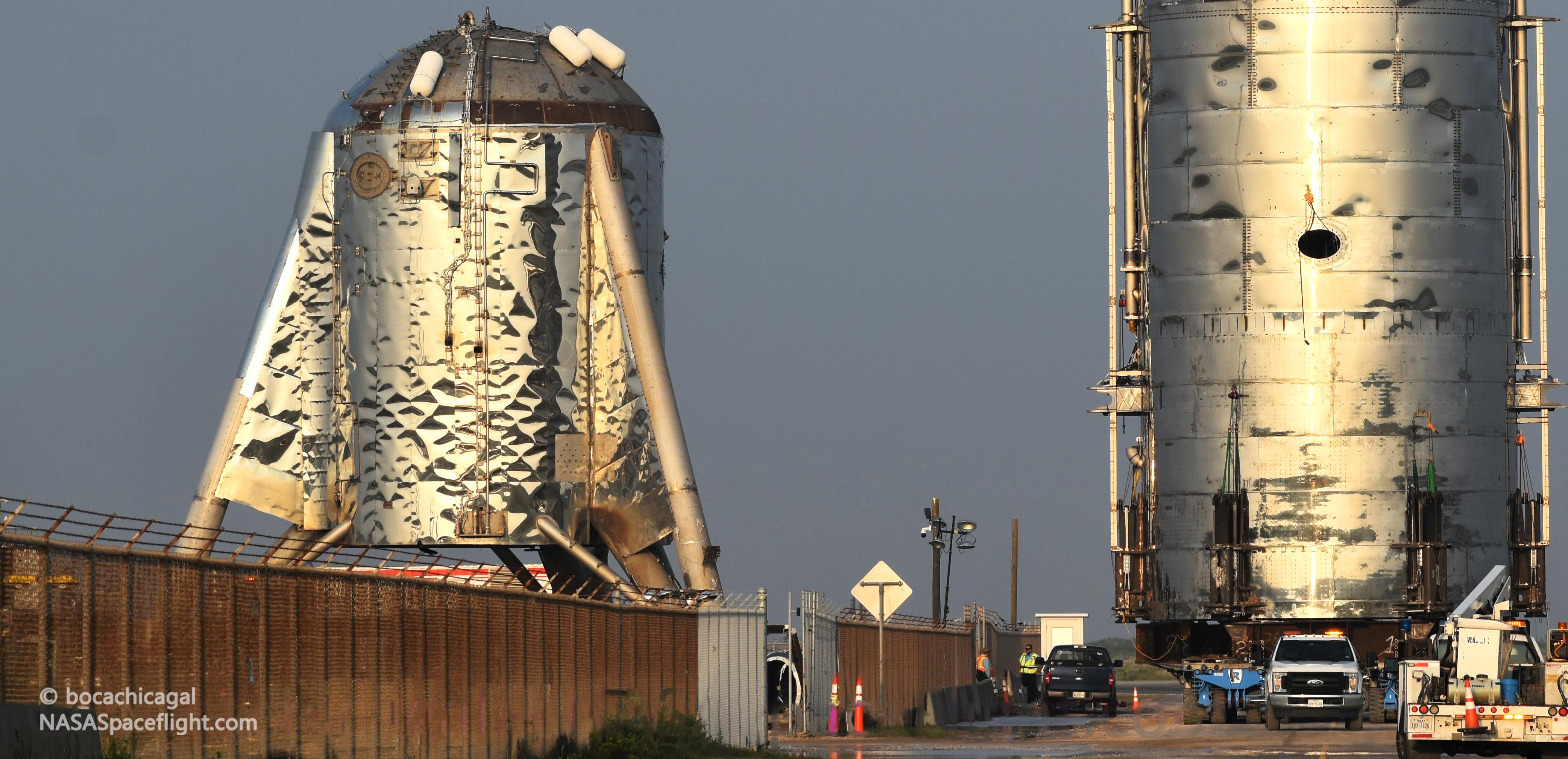

News
Elon Musk gifts SpaceX Starship angel investor a piece of Starhopper history
According to photos posted by the Japanese investor, SpaceX CEO Elon Musk has gifted Yusaku Maezawa a significant piece of Starhopper history, a celebration of the rocket prototype’s successful flight tests and a gesture of thanks for Maezawa’s substantial support.
Back in September 2018, Musk revealed that Japanese billionaire Yusaku Maezawa had become the first true customer for SpaceX’s next-generation Starship launch vehicle. In fact, Maezawa announced DearMoon, a private spaceflight venture with the aim of sending a dozen or so artists on the first commercial crewed mission around the Moon – all for free.
In a bid to assist Starship development and simultaneously secure rights to the massive spacecraft’s first crewed lunar launch, Maezawa committed what is believed to be several hundred million dollars of his personal fortune to SpaceX. In turn, the Japanese billionaire plans to select roughly a dozen artists from around the world and offering them a free ticket aboard Starship’s first crewed circumlunar launch, traveling once around the Moon and returning to Earth after 10 or so days in space.
Perhaps just a few weeks after the DearMoon announcement and Starship event, SpaceX CEO Elon Musk decided to radically change the Starship program, entirely replacing the vehicle’s main structural material of choice – carbon fiber composites – with stainless steel. The primary goal was to dramatically lower the cost of development and vehicle production and speed things up, but Musk quickly realized that steel could unintuitively be better than carbon fiber in almost every way.
After Musk’s decision, SpaceX pivoted from carbon fiber to steel at a spectacular pace. Barely six months after the design change, a SpaceX team had built up its Boca Chica, Texas facilities from almost nothing, begun to build full-scale steel hardware, and nearly completed the first low-fidelity prototype, known as Starhopper. That vehicle began propellant loading and wet dress rehearsal testing in early-April 2019 and although technical difficulties with its next-generation Raptor engines caused several months of delays, it moved into its first flight test campaign three months later.
Starhopper’s first untethered flight was completed successfully on July 25th, reaching an apogee of ~18 meters (60 ft). A little over one month later, Starhopper lifted off for the second time on a significantly more ambitious ~150m (500 ft) flight test, completed successfully after about 60 seconds in flight. That second test would be Starhopper’s last and SpaceX quickly turned its focus to completing the first full-scale, full-fidelity Starship prototypes, known as Mk1 (TX) and Mk2 (FL).
Throughout this process, Yusaku Maezawa has followed along with SpaceX. Rather than a simple lump-sum agreement, the billionaire’s contract with SpaceX is structured much more specifically, essentially allowing the company to unlock additional funding after certain milestones – like Starhopper’s flight tests – are completed. The arrangement is more of a carrot on a stick than something dead-serious – Maezawa is probably not going to completely withhold funding if SpaceX slightly misses exact targets or suffers anomalies during a complex launch vehicle development program.
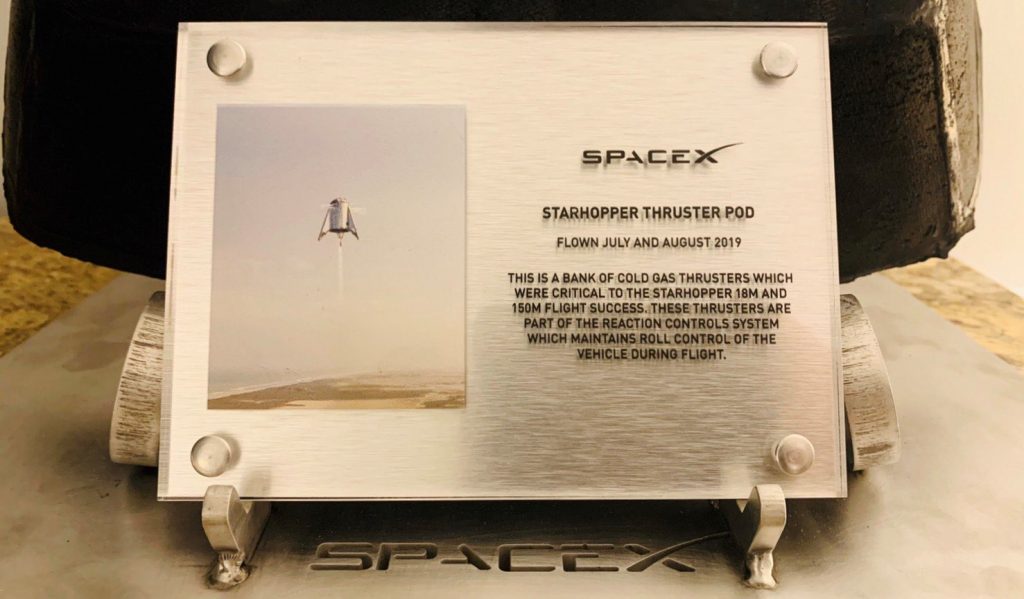
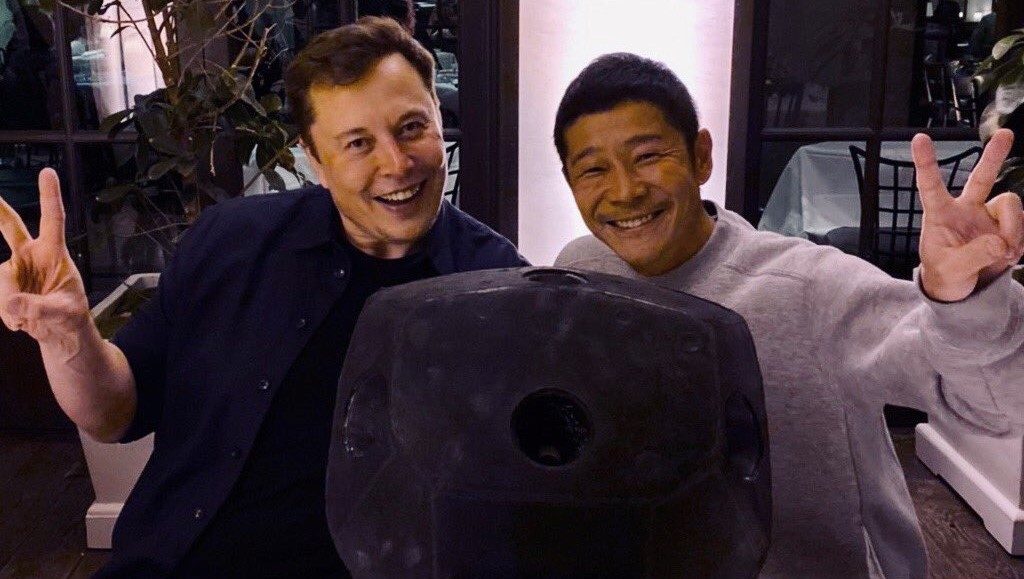
In order to complete its two flight tests, Starhopper needed some kind of attitude control system (ACS) to remain stable and SpaceX chose a decidedly SpaceX-y solution, simply bolting on flight-proven Falcon 9 thruster pods. Those pods use high-pressure nitrogen to change Falcon 9’s attitude, correctly point the rocket, and settle its propellant while the rocket is in a vacuum (or freefall). They can also provided limited control authority in atmosphere, which is what SpaceX used them for on Starhopper.
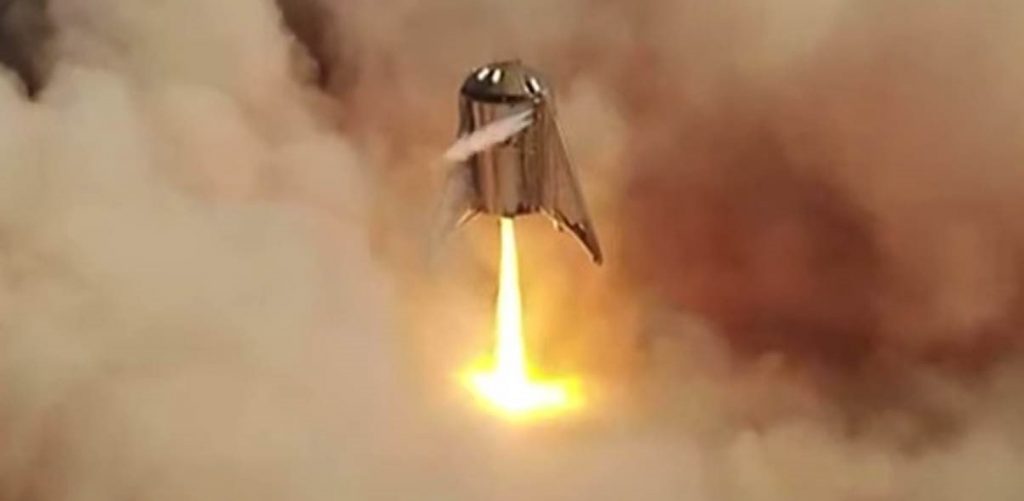
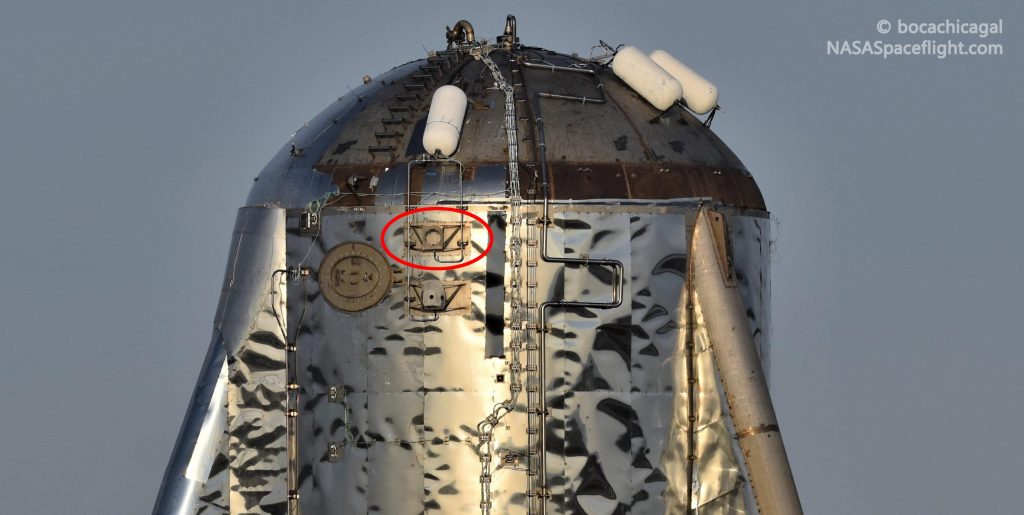
As a gesture of gratitude for Maezawa’s extremely helpful financial support, SpaceX gifted him an entire Starhopper thruster pod. SpaceX often does similar things for major flight milestones, creating commemorative gifts out of retired hardware (rocket tanks, engine bells, grid fins, parachute threads, etc.) that employees are able to purchase. An entire thruster pod is at least a few orders of magnitude above that, a sign of just how grateful SpaceX is to Maezawa.
Of note, in his tweet showing off the thruster pod, Maezawa suggested that “Starship development is going better than expected”, indicating that he may “need to invite a passenger soon” for his planned circumlunar voyage around the Moon. Prior to Starship’s radical shift from carbon fiber to steel, that mission was scheduled no earlier than 2023. In recent months, SpaceX executives have made it clear that they are now targeting Starship Moon landings by 2022, suggesting that the first circumlunar missions – a far easier task than landing – could be possible even sooner than that.
Check out Teslarati’s Marketplace! We offer Tesla accessories, including for the Tesla Cybertruck and Tesla Model 3.
News
Tesla UK sales see 14% year-over-year rebound in June: SMMT data
The SMMT stated that Tesla sales grew 14% year-over-year to 7,719 units in June 2025.

Tesla’s sales in the United Kingdom rose in June, climbing 14% year-over-year to 7,719 units, as per data from the Society of Motor Manufacturers and Traders (SMMT). The spike in the company’s sales coincided with the first deliveries of the updated Model Y last month.
Model Y deliveries support Tesla’s UK recovery
Tesla’s June performance marked one of its strongest months in the UK so far this year, with new Model Y deliveries contributing significantly to the company’s momentum.
While the SMMT listed Tesla with 7,719 deliveries in June, independent data from New AutoMotive suggested that the electric vehicle maker registered 7,891 units during the month instead. However, year-to-date figures for Tesla remain 2% down compared to 2024, as per a report from Reuters.
While Tesla made a strong showing in June, rivals are also growing. Chinese automaker BYD saw UK sales rise nearly fourfold to 2,498 units, while Ford posted the highest EV growth among major automakers, with a more than fourfold increase in the first half of 2025.
Overall, the UK’s battery electric vehicle (BEV) demand surged 39% to to 47,354 units last month, helping push total new car sales in the UK to 191,316 units, up 6.7% from the same period in 2024.
EV adoption accelerates, but concerns linger
June marked the best month for UK car sales since 2019, though the SMMT cautioned that growth in the electric vehicle sector remains heavily dependent on discounting and support programs. Still, one in four new vehicle buyers in June chose a battery electric vehicle.
SMMT Chief Executive Mike Hawes noted that despite strong BEV demand, sales levels are still below regulatory targets. “Further growth in sales, and the sector will rely on increased and improved charging facilities to boost mainstream electric vehicle adoption,” Hawes stated.
Also taking effect this week was a new US-UK trade deal, which lowers tariffs on UK car exports to the United States from 27.5% to 10%. The agreement could benefit UK-based EV producers aiming to expand across the country.
News
Tesla Model 3 ranks as the safest new car in Europe for 2025, per Euro NCAP tests
Despite being on the market longer than many of its rivals, the Tesla Model 3 continues to set the bar for vehicle safety.

The Tesla Model 3 has been named the safest new car on sale in 2025, according to the latest results from the Euro NCAP. Among 20 newly tested vehicles, the Model 3 emerged at the top of the list, scoring an impressive 359 out of 400 possible points across all major safety categories.
Tesla Model 3’s safety systems
Despite being on the market longer than many of its rivals, the Tesla Model 3 continues to set the bar for vehicle safety. Under Euro NCAP’s stricter 2025 testing protocols, the electric sedan earned 90% for adult occupant protection, 93% for child occupant protection, 89% for pedestrian protection, and 87% for its Safety Assist systems.
The updated Model 3 received particular praise for its advanced driver assistance features, including Tesla’s autonomous emergency braking (AEB) system, which performed well across various test scenarios. Its Intelligent Speed Assistance and child presence detection system were cited as noteworthy features as well, as per a WhatCar report.
Other notable safety features include the Model 3’s pedestrian-friendly pop-up hood and robust crash protection for both front and side collisions. Euro NCAP also highlighted the Model 3’s ability to detect vulnerable road users during complex maneuvers, such as turning across oncoming traffic.
Euro NCAP’s Autopilot caution
While the Model 3’s safety scores were impressive across the board, Euro NCAP did raise concerns about driver expectations of Tesla’s Autopilot system. The organization warned that some owners may overestimate the system’s capabilities, potentially leading to misuse or inattention behind the wheel. Even so, the Model 3 remained the highest-scoring vehicle tested under Euro NCAP’s updated criteria this year.
The Euro NCAP’s concerns are also quite interesting because Tesla’s Full Self-Driving (FSD) Supervised, which is arguably the company’s most robust safety suite, is not allowed for public rollout in Europe yet. FSD Supervised would allow the Model 3 to navigate inner city streets with only minimal human supervision.
Other top scorers included the Volkswagen ID.7, Polestar 3, and Geely EX5, but none matched the Model 3’s total score or consistency across categories. A total of 14 out of 20 newly tested cars earned five stars, while several models, including the Kia EV3, MG ZS, and Renault 5, fell short of the top rating.
Elon Musk
Why Tesla’s Q3 could be one of its biggest quarters in history
Tesla could stand to benefit from the removal of the $7,500 EV tax credit at the end of Q3.

Tesla has gotten off to a slow start in 2025, as the first half of the year has not been one to remember from a delivery perspective.
However, Q3 could end up being one of the best the company has had in history, with the United States potentially being a major contributor to what might reverse a slow start to the year.
Earlier today, the United States’ House of Representatives officially passed President Trump’s “Big Beautiful Bill,” after it made its way through the Senate earlier this week. The bill will head to President Trump, as he looks to sign it before his July 4 deadline.
The Bill will effectively bring closure to the $7,500 EV tax credit, which will end on September 30, 2025. This means, over the next three months in the United States, those who are looking to buy an EV will have their last chance to take advantage of the credit. EVs will then be, for most people, $7,500 more expensive, in essence.
The tax credit is available to any single filer who makes under $150,000 per year, $225,000 a year to a head of household, and $300,000 to couples filing jointly.
Ending the tax credit was expected with the Trump administration, as his policies have leaned significantly toward reliance on fossil fuels, ending what he calls an “EV mandate.” He has used this phrase several times in disagreements with Tesla CEO Elon Musk.
Nevertheless, those who have been on the fence about buying a Tesla, or any EV, for that matter, will have some decisions to make in the next three months. While all companies will stand to benefit from this time crunch, Tesla could be the true winner because of its sheer volume.
If things are done correctly, meaning if Tesla can also offer incentives like 0% APR, special pricing on leasing or financing, or other advantages (like free Red, White, and Blue for a short period of time in celebration of Independence Day), it could see some real volume in sales this quarter.
You can now buy a Tesla in Red, White, and Blue for free until July 14 https://t.co/iAwhaRFOH0
— TESLARATI (@Teslarati) July 3, 2025
Tesla is just a shade under 721,000 deliveries for the year, so it’s on pace for roughly 1.4 million for 2025. This would be a decrease from the 1.8 million cars it delivered in each of the last two years. Traditionally, the second half of the year has produced Tesla’s strongest quarters. Its top three quarters in terms of deliveries are Q4 2024 with 495,570 vehicles, Q4 2023 with 484,507 vehicles, and Q3 2024 with 462,890 vehicles.
-

 Elon Musk4 days ago
Elon Musk4 days agoTesla investors will be shocked by Jim Cramer’s latest assessment
-

 News1 week ago
News1 week agoTesla Robotaxi’s biggest challenge seems to be this one thing
-

 Elon Musk2 weeks ago
Elon Musk2 weeks agoFirst Look at Tesla’s Robotaxi App: features, design, and more
-

 News2 weeks ago
News2 weeks agoSpaceX and Elon Musk share insights on Starship Ship 36’s RUD
-

 News2 weeks ago
News2 weeks agoWatch Tesla’s first driverless public Robotaxi rides in Texas
-

 News1 week ago
News1 week agoWatch the first true Tesla Robotaxi intervention by safety monitor
-

 News2 weeks ago
News2 weeks agoTesla has started rolling out initial round of Robotaxi invites
-

 Elon Musk2 weeks ago
Elon Musk2 weeks agoTesla to launch in India in July with vehicles already arriving: report

















